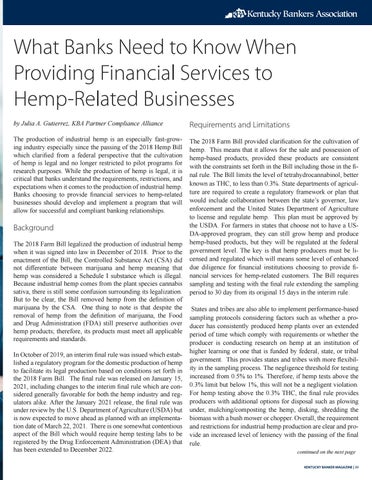What Banks Need to Know When Providing Financial Services to Hemp-Related Businesses by Julia A. Gutierrez, KBA Partner Compliance Alliance
Requirements and Limitations
The production of industrial hemp is an especially fast-growing industry especially since the passing of the 2018 Hemp Bill which clarified from a federal perspective that the cultivation of hemp is legal and no longer restricted to pilot programs for research purposes. While the production of hemp is legal, it is critical that banks understand the requirements, restrictions, and expectations when it comes to the production of industrial hemp. Banks choosing to provide financial services to hemp-related businesses should develop and implement a program that will allow for successful and compliant banking relationships.
The 2018 Farm Bill provided clarification for the cultivation of hemp. This means that it allows for the sale and possession of hemp-based products, provided these products are consistent with the constraints set forth in the Bill including those in the final rule. The Bill limits the level of tetrahydrocannabinol, better known as THC, to less than 0.3%. State departments of agriculture are required to create a regulatory framework or plan that would include collaboration between the state’s governor, law enforcement and the United States Department of Agriculture to license and regulate hemp. This plan must be approved by the USDA. For farmers in states that choose not to have a USDA-approved program, they can still grow hemp and produce hemp-based products, but they will be regulated at the federal government level. The key is that hemp producers must be licensed and regulated which will means some level of enhanced due diligence for financial institutions choosing to provide financial services for hemp-related customers. The Bill requires sampling and testing with the final rule extending the sampling period to 30 day from its original 15 days in the interim rule.
Background The 2018 Farm Bill legalized the production of industrial hemp when it was signed into law in December of 2018. Prior to the enactment of the Bill, the Controlled Substance Act (CSA) did not differentiate between marijuana and hemp meaning that hemp was considered a Schedule I substance which is illegal. Because industrial hemp comes from the plant species cannabis sativa, there is still some confusion surrounding its legalization. But to be clear, the Bill removed hemp from the definition of marijuana by the CSA. One thing to note is that despite the removal of hemp from the definition of marijuana, the Food and Drug Administration (FDA) still preserve authorities over hemp products; therefore, its products must meet all applicable requirements and standards. In October of 2019, an interim final rule was issued which established a regulatory program for the domestic production of hemp to facilitate its legal production based on conditions set forth in the 2018 Farm Bill. The final rule was released on January 15, 2021, including changes to the interim final rule which are considered generally favorable for both the hemp industry and regulators alike. After the January 2021 release, the final rule was under review by the U.S. Department of Agriculture (USDA) but is now expected to move ahead as planned with an implementation date of March 22, 2021. There is one somewhat contentious aspect of the Bill which would require hemp testing labs to be registered by the Drug Enforcement Administration (DEA) that has been extended to December 2022.
States and tribes are also able to implement performance-based sampling protocols considering factors such as whether a producer has consistently produced hemp plants over an extended period of time which comply with requirements or whether the producer is conducting research on hemp at an institution of higher learning or one that is funded by federal, state, or tribal government. This provides states and tribes with more flexibility in the sampling process. The negligence threshold for testing increased from 0.5% to 1%. Therefore, if hemp tests above the 0.3% limit but below 1%, this will not be a negligent violation. For hemp testing above the 0.3% THC, the final rule provides producers with additional options for disposal such as plowing under, mulching/composting the hemp, disking, shredding the biomass with a bush mower or chopper. Overall, the requirement and restrictions for industrial hemp production are clear and provide an increased level of leniency with the passing of the final rule. continued on the next page KENTUCKY BANKER MAGAZINE | 39










